When it comes to history, circa 5th century BC, the Greeks considered the Celts (Keltoi) as one of the four great ‘barbarian’ people – with their independent realms extending all the way from the Iberian peninsula to the frontiers of the upper Danube, encompassing large swathes of Western and Central Europe.
From the cultural perspective, these Celtic tribes and bands posed the antithesis to the so-presumed Mediterranean ideals, with their distinctive approach to religion and warfare. But of course, beyond the misleading ‘barbarian’ tag, there was more to the historical scope of these ancient people, particularly the fierce Celtic warriors.
Contents
- High Chieftains, Nobles, and ‘Magistrates’
- The ‘Men of Art’ in Celtic Culture
- The Scope of Clientage in Celtic Society
- Low-Intensity Celtic Warfare and Mercenaries
- The ‘Solution’ of Wealth and Prestige
- Feasting and Raiding
- Druids and The Otherworld
- The Arms and Armor of the Celtic Warrior
- The Battle Deployment of Ancient Celts
- The Contrast between Rich Clothes and Ritual Nudity
- The Frenzied Charge and Cacophony of the Celtic Warriors
- The Lime-Washed Hair and Tattoos
High Chieftains, Nobles, and ‘Magistrates’
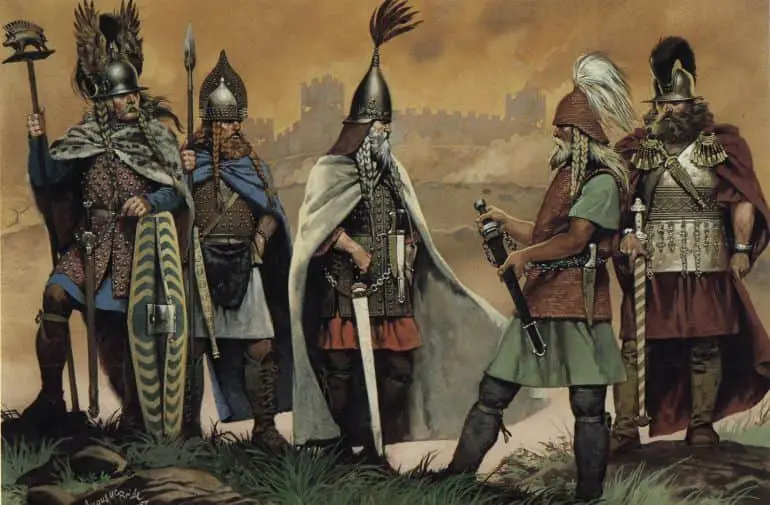
Like most tribal scopes of ancient times, the basic framework of the Celtic society was composed of extended families and clans who were based within their particular territories. These collective groups, often categorized as Celtic tribes, were ruled by kings or high chieftains, with power sometimes shared by dual authorities.
Over time, by circa 1st century BC, some of the Celts, especially in Gaul (modern France), were ruled by elected ‘magistrates’ (similar to Roman consuls) – although these figureheads only wielded nominal power. The real decision-making was left to the assembly of free men, while the military orders (like raiding and conquests) were still carried forth by an even smaller group of nobles, among whom the kings and chieftains were chosen.
This brings us to the basic hierarchy of the ancient Celts, where the nobles obviously formed the minority of elites. They were followed by the aforementioned free men of the Celtic tribes, who often formed the warbands and retainers (Celtic armies) of their chiefs. But the majority of the common Celtic people were probably of ‘unfree’ origin, whom Julius Caesar likened to slaves.
Now from the practical perspective, this was an oversimplification. That is because the Celts were not really dependent on slaves for the functioning of their social and economic affairs, as opposed to their Mediterranean neighbors. So the unfree nature of many of these folks might have been similar to the limited rights of serfs from later medieval Europe.
However, the Celts (especially the elites) actually thrived on the trading of slaves – whom they rounded up in raids. And these captured men and women were often bartered in return for luxury goods from Rome and distant Greece.
The ‘Men of Art’ in Celtic Culture
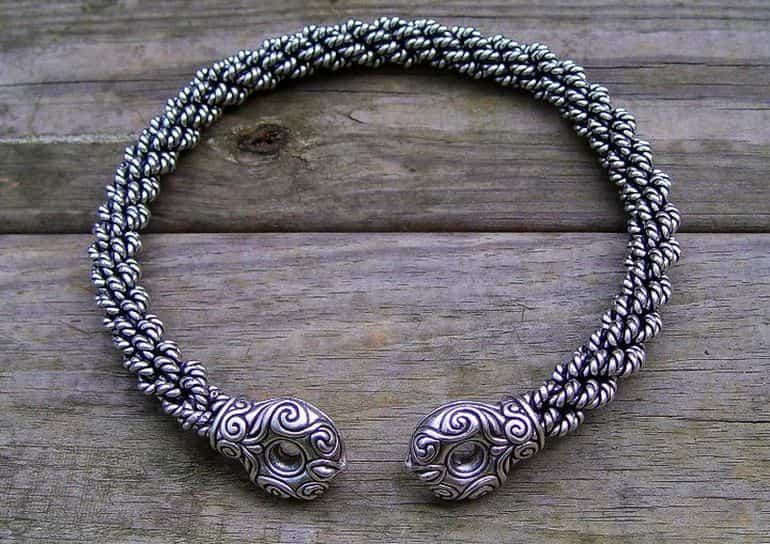
Interestingly enough, in spite of their (often misleading) ‘barbarian’ tag, the Celtic society held the so-categorized ‘men of art’ in high regard. In fact, in ancient Ireland, the Druids were called forth as ‘men of art’ and were accorded special privileges by the ruling class.
Similarly, bards, artisans, blacksmiths, and metalworkers were often heralded as men of art, given their contributions to the crafting of morale-boosting songs (in Celtic languages), ostentatious jewelry, and most importantly mass weapons – items that had high value in the Celtic society.
In fact, the categorization of ‘men of art’ was so important that the nobles often endowed themselves with similar titles. This was complemented by their patronizing of various types of craftsmen, who in turn were responsible for furnishing special apparel and accouterments for their chosen lords and leaders.
In essence, the flourishing and encouragement of art was an integral part of the Celtic society, with the status being used to both fuel and associate itself with the ‘men of art’. Archaeology rather reinforces such an art-based social system, as could be evidenced by the Celtic material culture found across parts of continental Europe.
The Scope of Clientage in Celtic Society
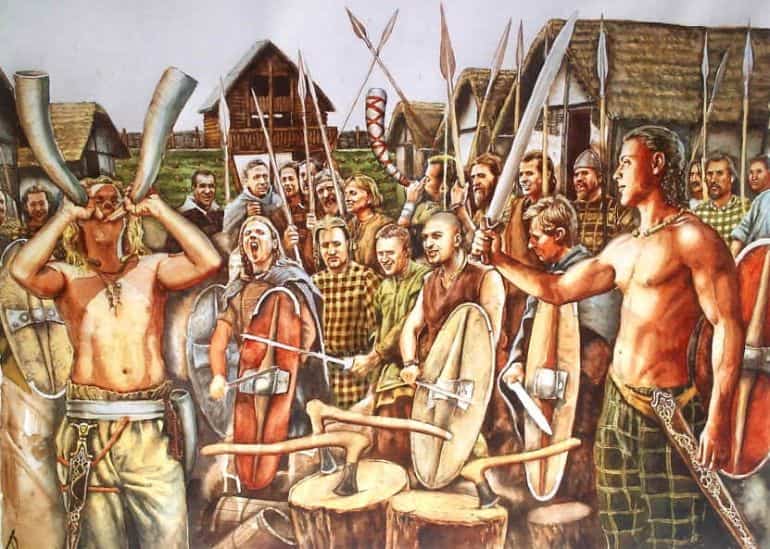
We fleetingly mentioned how the Celtic society could be basically divided into three groups – the rich nobles, the free-men retainers, and the majority of common folks (who enjoyed better standards than Mediterranean slaves). Intriguingly enough, the entire societal scope was structured in a way that allowed these three groups to be connected to each other – and the system was based on clientage.
Simply put, like the later feudal times, the scope of clients meant that the lower-ranking group pledged allegiance to their political superiors in return for security (like the common folks) and employment (like the free men) within the tribe.
On the other hand, the number of retainers (or clients) of a noble mirrored his standing within the tribe; with a higher number of followers obviously reflecting the elite’s greater prestige and power. It should be also noted that many nobles depended on free men for support during times of war and confrontations.
Now while this interconnected system was based on practicality, it was strengthened by vows of loyalty that were not taken lightly – and thus had rigorous consequences for those who broke such established ties. Moreover, given the importance of familial ties in the Celtic tribes, the client system was sometimes reinforced with the exchange of hostages and fostering of children.
And in desperate situations, clientage even extended to entire tribes, as was the case during Caesar’s Gaul campaign (the Gallic Wars) when the Aedui called upon their allied clients for battle.
Low-Intensity Celtic Warfare and Mercenaries
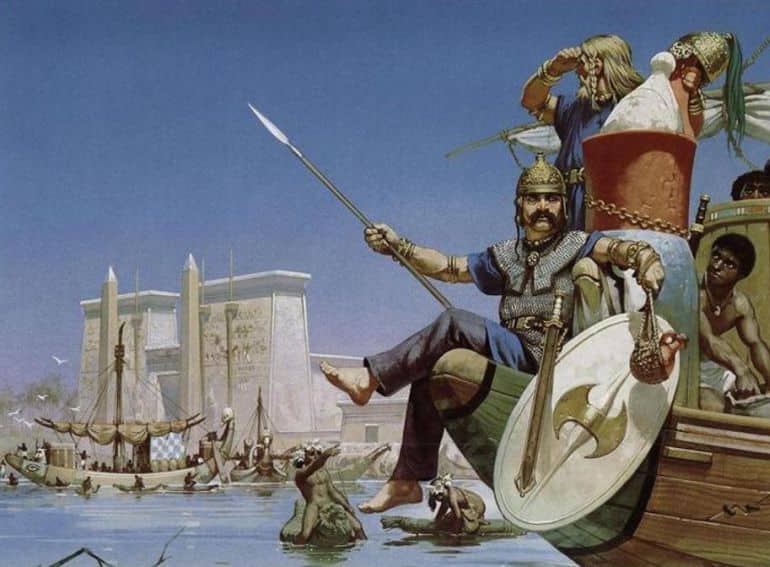
One of the intrinsic characteristics of an ancient Celtic society was based on the mutual appreciation of physical security. This in turn endowed the nobles with the power of ‘providing’ security. And the scope of security was needed quite regularly since the Celts were often involved in ‘aggressive’ activities, ranging from cattle rustling, slave raiding, and trading to even clan-based vendettas and warfare.
In fact, these low-intensity conflicts rather prepared the young warriors for actual Celtic warfare, not only psychologically (since courage was not seen as a virtue but rather viewed as expected behavior), but also tactically, like honing his weapon-handling and most importantly demonstrating his martial reputation as a warrior.
One of the ways to gain such a reputation was to join the mercenary bands that operated in many geographical locations dotted around ancient Europe and the Mediterranean. A pertinent example would obviously entail the many Celtic warriors employed by the great Hannibal. Among the Carthaginian general’s Gaulish contingent, the Celtic cavalry was specially held in high regard due to their effectiveness in close combat and elite status (often led by noblemen).
The Celts also proved their value as mercenaries in the armies of Syracuse and even the Diadochi (Successor) Kingdoms of Alexander, with one intriguing example relating how they operated as elite infantrymen in the military of the Ptolemies of Egypt (pictured above).
Many of these mercenary bands acted as pseudo-brotherhoods, with their army fraternity codes being distinct from the ‘ordinary’ soldiers of the numerous clans and tribes. Polybius noted how the Celtic mercenaries who arrived from the north to aid their Cisalpine Gaul brethren at the Battle of Telamon (against the Romans) were called the Gaesatae or simply ‘spearmen’. However, the term itself may have been derived from the Celtic word geissi, which roughly translated to bonds or sacred rules of conduct.
The ‘Solution’ of Wealth and Prestige
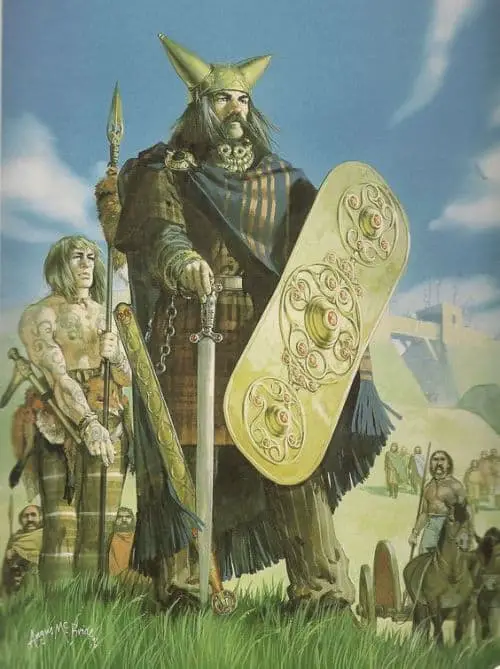
The hierarchy of the ancient Celtic society was partially inspired by the prestige of the leader or the chieftain. And this flair of prestige, in turn, was determined by the wealth he had acquired through numerous endeavors, ranging from raiding, and warring to even trading.
In essence, the war chiefs understood that the greater wealth they acquired, the bigger the chance that they will have to retain their clients and thus wield power. One of the by-effects of this simple economic system was mentioned in the earlier entry, where selected groups of Celtic warriors became mercenaries, thus gathering riches and spoils from the distant lands of Greece, Egypt, and even the Roman Empire; thus enhancing their prestige in their native lands.
Another interesting example would pertain to the trading of slaves. While rounding up slaves was relatively easy for the Celtic warbands given the loose structure of many fringe villages and settled lands (when compared to their Mediterranean counterparts), these slaves were often not integrated into the Celtic society.
Instead, they were traded for luxury goods like wine and gold coins. Now while for a Mediterranean merchant, the deal was seen as being ‘too easy’ – since slaves were often more profitable than mere fixed commodities, the trade was practical for a Celtic warlord. That is because the acquisition of wines (and luxury goods) and their distribution among his retainers would actually reinforce his standing within the tribe structure.
Feasting and Raiding

Much like their Germanic neighbors, the ancient Celts gave special significance to feasting. These social gatherings, patronized by the nobles, almost took a ritualistic route, with a variety of ceremonial features and hospitality codes.
At the same time, the participants themselves often became drunk and wild, and their furor was accompanied by bard songs and even parodies that praised or made sarcastic remarks about their lineage and courage.
But beyond drunkenness and revelry, such feasts also mirrored the social standing of the patrons and the guests, with seating arrangements reflecting their statuses within the community (much like the later Anglo-Saxons).
Furthermore, even the meat cuts reflected the stature and prominence of the guest, with the choicest pieces being given to the favorite warriors. This champion’s portion could even be disputed by other warriors, which led to arguments and even fighting among the guests.
Furthermore, the feasts also served the practical purpose of military planning because such social gatherings attracted many of the notable elites and influential retainers. So while drinking and feasting, any Celtic warrior could boast of his planned raid for plundering and gathering spoils – and he could ask other followers to join him.
The scope once again reverted to prestige; war chiefs with greater social standing had more clients to support them in a quest to gather even more riches – thus alluding to a cyclic economy based on warfare.
Druids and The Otherworld

So far, we had been talking about the social aspects of the ancient Celts. However, a big part of the Celtic culture was based on the spiritual and supernatural scope. As a matter of fact, Celtic warriors tended to associate supernatural properties with many natural parameters, including bogs, rivers, lakes, mountains, and even trees.
The spiritual scope and its characteristics also extended to certain animals and birds, like horses, wild boars, dogs, and ravens. To that end, many of the Celts considered the tangible realm of man to be co-existing with the Otherworld where the gods and dead resided.
At times the boundary between these two realms was judged to be ‘thinned’, and as such few of the human sacrifices (like the Lindow Man) were possibly made to ‘send’ a messenger into this fantastical Otherworld.
The eminence of the Druids stemmed from their alleged capacity to ‘link’ and interpret the Otherworld. Their very name is derived from the cognate for oak trees; with the sacred grove of oak trees, known as drunemeton (in Galatia), being used for important rituals and ceremonies.
In that regard, while Druids were more popular in ancient Gaul and Britain, men with high social status who acted as the guardians of tribal traditions were fairly common in the Celtic world (even in distant Galatia in Asia Minor).
The Arms and Armor of the Celtic Warrior

All the freemen of the ancient Celtic society had the right (and sometimes duty) to bear arms, as opposed to the ‘unfree’ majority. The weapons they carried, though, were relatively uncomplicated with the spears and shields combination being the norm.
The nobility, however, tended to showcase their long swords as instruments of prestige (and slashing weapons), while also incorporating helmets and mail shirts as part of their battle panoply (although only worn by the higher status warriors). In contrast, ordinary warriors only carried their spears, and short shields, while eschewing any form of heavy armor.
Interestingly enough, other than the sword, the spear was also viewed as an esteemed (and practical) weapon of a warrior. Greek author Strabo described how the ancient Celtic warrior often carried two types of the spear – a bigger, heavier one for thrusting; and a smaller, flexible one for throwing and (sometimes) using in close combat.
As for defensive equipment, Greek traveler Pausanias commented on how the Galatae (Galatians – Celtic people who migrated and settled in central Anatolia) carried their distinctive shields. Livy further attested how the Celtic shields were relatively long with an oblong shape But practicality once again suggests that heavy shields were probably only carried by the elite retinues.
As for missile weapons, archaeological evidence suggests that bows were in very low demand for Celtic warriors. On the other hand, there are plenty of sling stones that have been found around the hill-forts of southern Britain, thereby alluding to how slings were probably more favored than bows as weapons by some Celtic groups. In any case, the very warrior ethos of most Celtic societies possibly played a part in looking down upon projectile-based weapons.
The Battle Deployment of Ancient Celts
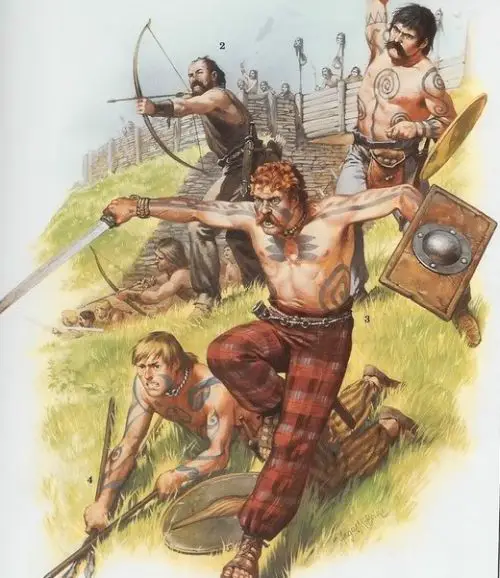
With all the talk about weapons, we must also understand that warfare was an intrinsic part of Celtic society. So while popular notions and Hollywood dismiss them as ‘barbarians’ who preferred to mass up and chaotically charge their enemies, the historicity is far more complex.
In fact, some ancient writers, like Polybius himself, mentioned how the Celts were no mere ‘column of the mob’. Instead, they probably deployed themselves on the battlefield based on tribes and their internal affiliations.
And almost mirroring their societal scope, the formations (or battle lines) of the army were inspired by the hierarchy. For example, the chosen and noble Celtic warriors boasting their reputation and courage were positioned on the front lines, surrounded by groups of other soldiers (who had their morale boosted by these champions).
These ‘super-groups’ with tribal affiliations carried forth their own standards and banners, often replete with religious symbolism (like guardian deities). And on a practical level, these standards were also used for rallying the front-line Celtic warriors, with contingents vying for supremacy and prestige on the battlefield.
The Contrast between Rich Clothes and Ritual Nudity
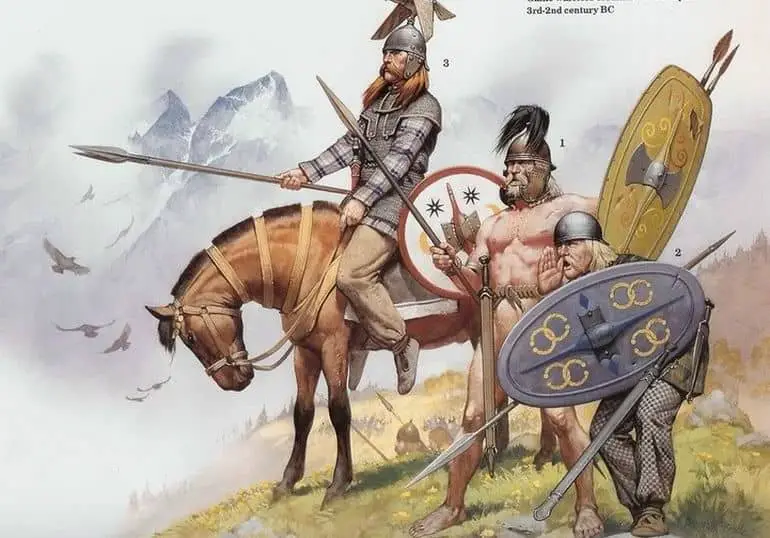
Pausanias talked about the Galatians (Galatae) and how they preferred to wear embroidered tunics and breeches with rich colors, often accompanied by cloaks striped with various tints. Archaeological evidence from Celtic graves and tombs also supports such a notion, with wool and linen clothing fragments often showcasing vibrant hues.
The nobles complimented their fashionable styles with opulence, including the use of gold threads and silk. Furthermore, the wealthy Celts (both men and women) also had a penchant for wearing jewelry items, like bracelets, rings, necklaces, torcs, and even entire corselets made of gold.
On the other hand, Polybius had this to say about the fierce Celts, circa 2nd century BC –
The Romans…were terrified by the fine order of the Celtic host, and the dreadful din, for there were innumerable horn-blowers and trumpeters, and…the whole army were shouting their war cries…Very terrifying too were the appearance and the gestures of the naked warriors in front, all in the prime of life and finely built men, and all in the leading companies richly adorned with gold torcs and armlets.
So in contrast to ostentatious clothing items, few Celtic warriors willingly plunged into the battle naked. Now on closer inspection of the ancient accounts, one could discern that these ‘naked warriors’ mostly belonged to the mercenary groups (Gaesatae), which we had earlier described as being prestigious organizations.
Simply put, some of the warriors in such groups, bound by codes and rituals, dedicated themselves to martial pursuits dictated by symbolism. Viewing themselves as ardent followers of gods of war (like Camulos in Gaul), these adherents possibly felt protected by divine entities, and thus boisterously shunned body armor. However, the naked warrior did carry his shield because that particular item was considered an integral part of his warrior panoply.
The Frenzied Charge and Cacophony of the Celtic Warriors
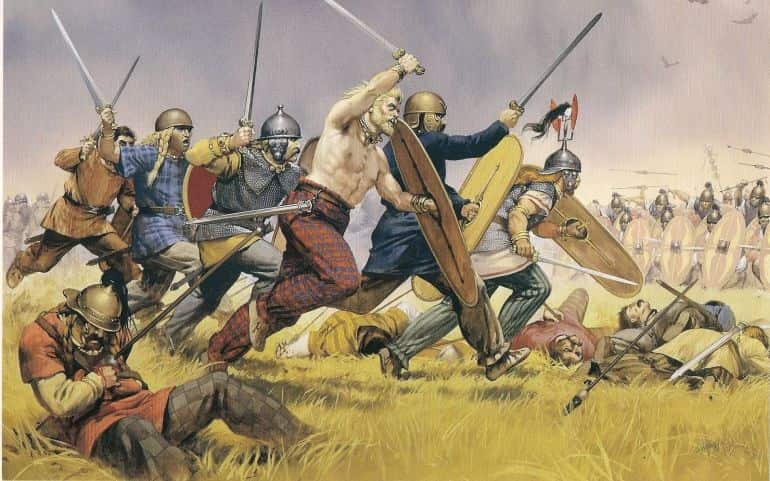
For the ancient Celts, in a sense, a battle was seen as an opportunity to prove one’s ‘value’ in front of the tribe and gods. So while the tactics of warfare evolved throughout the centuries in ancient Europe, the psychological approach of the Celtic warriors to warfare largely remained unchanged.
And accompanying his psyche was the purposeful use of noise, ranging from battle cries, songs, chants, taunts, and insults to even specialized instruments like carnyx. This latter-mentioned object was usually a sort of a war horn that was shaped like an animal (often a boar), and its primary purpose was to terrify the enemy with ‘harsh sounds and tumults of war’ (as described by Diodorus Siculus).
Interestingly enough, the very word ‘slogan’ is derived from the late-Medieval term slogorne, which in turn originates from Gaelic sluagh-ghairm (sluagh meaning ‘army’; gairm pertaining to ‘cry’), the battle cry used by the Scottish and Irish Celts. The Celtic warbands were sometimes also accompanied by Druids and ‘banshee’ women who made their presence known by shouting and screeching curses directed at their foes.
Apart from psychologically afflicting the enemy, the ‘auditory accompaniment’ significantly drummed up the courage and furor of the Celtic warriors. By this time (in the beginning phase of the battle), the challenge was issued – when their champions emerged forth to duel with their opponents.
And once the single combats were performed, the Celts were driven into their battle-frenzy – and thus they charged at the enemy lines with fury. As Julius Caesar himself described one of the frenzied charges made by the Nervii at the Battle of the Sambre (in Gallic War Book II)-
…they suddenly dashed out in full force and charged our cavalry, easily driving them back and throwing them into confusion. They then ran down to the river with such incredible speed that it seemed to us as if they were at the edge of the wood, in the river, and on top of us almost all at the same moment. Then with the same speed, they swarmed up the opposite hill towards our camp and attacked the men who were busy fortifying it.
The Lime-Washed Hair and Tattoos
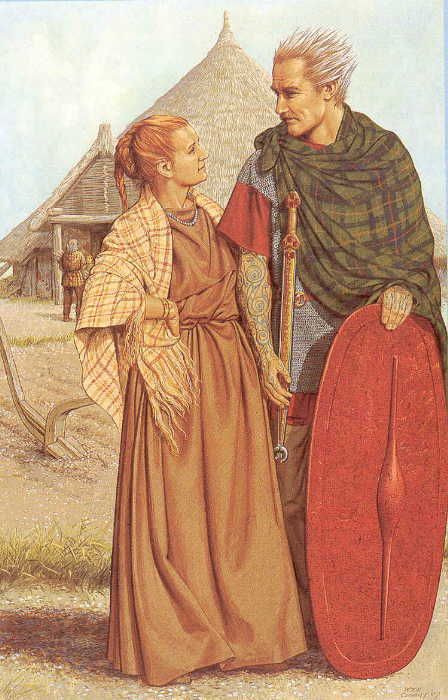
Diodorus Siculus, along with other ancient authors, also mentions how the Celts used to artificially ‘whiten’ their hair with lime water. This practice probably alluded to a ritual where the warrior adopted the horse as his totem, and thus aspired for the blessings and protection of Eponia, the horse goddess.
Interestingly enough, the lime-washing possibly even hardened the hair to some degree (though overuse caused the hair to fall out), which could have offered slight protection against the fluky slashes directed towards the head. Many Celtic warriors, especially from the British Isles, also tattooed their skin with blue dye derived from the woad plant – as made famous by the Woad Raiders from the strategy game Age of Empires II.
Sources: Ancient Encyclopedia / LiveScience / HistoryWorld / Shoreline.edu / Skyelander
Book References: Celtic Warrior 300 BC-AD 100 (By Stephen Allen – Osprey Publishing) / Ancient Celts: Europe’s Tribal Ancestors (By Kathryn Hinds)
And in case we have not attributed or misattributed any image or artwork, please let us know via the ‘Contact Us’ link, provided both above the top bar and at the bottom bar of the page.
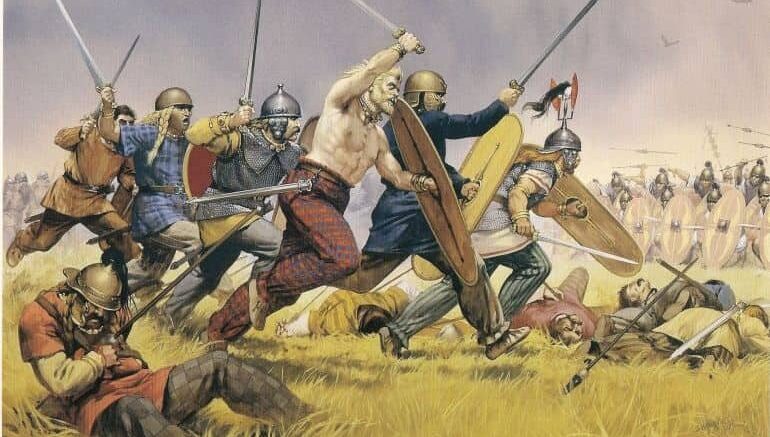
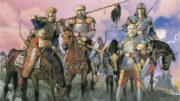
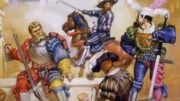
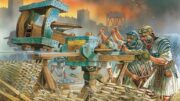

Be the first to comment on "Ancient Celtic Warriors: 12 Things You Should Know"